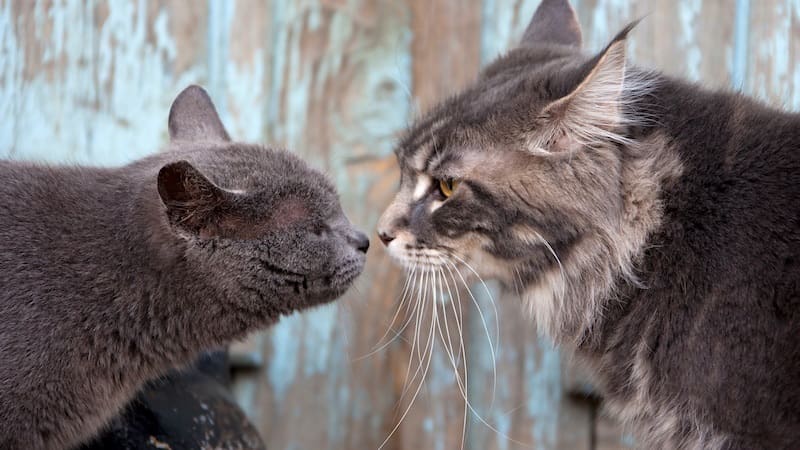It is important to be aware of the warning signs when introducing cats. Knowing what these telltale signs look like and how to respond appropriately can help ensure a successful introduction for both your new cat and your resident cat.
It takes time for indoor cats to get used to living together but understanding the best way to introduce them and monitoring their progress along the way will increase your chances of success.
Read on to discover more about warning signs when introducing cats, tips on creating a smooth introduction process, how you should monitor your cat’s behaviour during this transition period and what steps you should take if they aren’t getting along as expected.
Warning Signs of Unhealthy Cat Introductions

When introducing two cats, it is important to be aware of the warning signs that indicate an unhealthy introduction. These behaviors can include aggressive behavior, hiding and withdrawal, and changes in appetite.
Aggressive Behavior:
Cats may display aggression when they are uncomfortable or stressed out by a new situation. Signs of aggression can include hissing, growling, swatting at each other with their paws, or even physical fighting.
If you notice any of these behaviors during the introduction process from either the resident cat or the new cat, separate them immediately and try again later after both have had time to calm down.
Hiding and Withdrawal:
Another sign that something isn’t going well is if either of the two cats start to hide away from each other or become withdrawn from their usual activities. This could mean that the resident cat is feeling overwhelmed by the presence of another cat in its space or that the new cat is feeling stressed due to his new home so it might be best to give them some more time apart before trying again with introductions.
Changes in Appetite:
A decrease in appetite can also signal stress for cats so keep an eye on how much food your cats are eating as this could provide insight into how comfortable they feel around each other.
If either cat stops eating altogether then take them to a vet right away as this could indicate a serious health issue unrelated to introductions but still worth checking out just in case.
It is important to monitor these behaviors closely when you introduce cats so you can catch any potential issues early on before things get worse between them. Taking action quickly will help ensure that your furry friends stay safe and content together.
Recap: When you introduce cats, be aware of warning signs such as aggressive behavior, hiding and withdrawal, and changes in appetite. Take action quickly if any of these behaviors are present to ensure that your furry friends stay safe and content together.
Tips for a Smooth Introduction

The RSPCA recommends having the new cat in a carry crate so that they are safe for the very first meet. If things go well you can then move on to the next phase.
Set up a room that can be used as a neutral territory where both cats can explore and get comfortable with each other’s presence.
Make sure there are plenty of hiding spots, scratching posts, toys, and beds available so they have enough stimulation and comfort while in this area.
Establishing positive associations between the two cats is also key for a successful introduction. Offer treats when they are together or provide interactive toys like feather wands that encourage playtime together instead of aggression towards one another.
It may take some time before the cats start playing together but rewarding good behavior during introductions helps build trust between them over time.
Providing plenty of stimulation is essential for keeping your cat’s stress levels low. Make sure there are plenty of activities available such as scratching posts, puzzle feeders, window perches, and cat trees so that your kitties can stay entertained throughout the day while getting used to being around each other more often than usual.
Additionally, make sure you keep up with regular vet visits to monitor any changes in behavior or health due to increased stress levels from introductions going on at home.
How to Monitor Your Cats’ Progress
Observing body language and interactions between cats is one of the best ways to monitor their progress. Cats communicate through body language, so it’s important to pay attention to how they interact with each other.
Look for signs such as tail twitching, ears flattened against the head, or hissing and growling. If you notice any aggressive behavior from either cat, separate them immediately and try again later when both cats are calm.
Keeping track of eating habits and bathroom use can also help you identify potential issues before they become serious problems. Make sure both cats have access to food bowls in different areas of your home so that neither feels threatened while eating.
Also keep an eye on litter box usage; if one cat stops using it or starts going outside the box, this could be a sign that something is wrong with their relationship.
Finally, monitoring stress levels with regular vet visits is essential for keeping your other cats healthy during introductions. Your vet will be able to check for physical symptoms such as weight loss or changes in appetite that may indicate underlying health issues related to stress.
They can also provide advice on how best to proceed with introducing your new cat if there are any problems along the way
What to Do if the Introduction is Not Going Well?

If the introduction process of two cats is not going well, it is important to take action in order to ensure that both cats are safe and healthy during the transition period.
Re-Introduce the Cats Slowly and Carefully:
It may be necessary to re-introduce the new cat slowly and carefully if their initial introduction did not go as planned. This can help reduce stress levels for both cats by allowing them time to get used to each other’s presence without feeling overwhelmed or threatened.
Start by placing one cat in a separate room with food, water, litter box, toys, and bedding while keeping the resident cat in another area of your home. Allow them short periods of supervised interaction until they become more comfortable around each other before introducing them again without supervision.
Seek Professional Help from an Animal Behaviorist or Veterinarian
If you feel like you need additional assistance with introducing your cats successfully, consider seeking professional help from an animal behaviorist or veterinarian who can provide advice on how best to proceed with a successful introduction process.
They will be able to assess any potential issues between your pets and offer guidance on how best to manage these issues so that both animals remain safe and happy during this transition period.
In some cases, it may be necessary for safety reasons or due to behavioral problems between two cats that cannot be resolved through training methods alone, for owners to keep their pets permanently separated from one another even after a successful reintroduction process has been completed.
If this is something you are considering, make sure you have adequate space available within your home so that each pet has its own designated cat’s room where they can eat, sleep, play and use their litter box without coming into contact with one another unnecessarily.
Recap: When introducing cats, it is important to do so slowly and carefully, and seek professional help if needed. Re-introduce the cats in separate rooms with food, water, litter box, toys and bedding before allowing them supervised interaction. Consider permanent separation if behavioral problems arise that cannot be resolved through training methods alone.
FAQ
What are good signs when introducing cats?

Introducing cats can be a tricky process, but there are some signs that indicate it is going well. When cats begin to rub against each other or share food and toys, this is a sign of acceptance. If they start to groom one another or play together, then the introduction has been successful.
Additionally, if the cats remain relaxed in each other’s presence without any hissing or growling, then this also indicates that the two animals have accepted one another.
Ultimately, when introducing cats it is important to watch for these positive behaviors as an indication of success.
What happens if you introduce cats too quickly?
Introducing cats too quickly can lead to aggression and stress. If two cats are introduced without proper acclimation, they may fight as cats are highly territorial. This could result in physical injury, psychological trauma, and a decrease in the quality of life for both cats.
Introducing cats too quickly can create tension between them that will be difficult to undo. To avoid this situation it is important to slowly introduce new cats into an existing household by providing separate spaces for each cat and gradually increasing their contact with one another over time.
What is normal behavior when introducing cats?
When introducing cats, it is important to ensure that the environment is calm and quiet. Start by allowing them to smell each other from a distance, then gradually increase their contact time over several days or weeks. It’s also important to provide plenty of hiding places for either cat in case they feel overwhelmed or scared, particularly if one is a dominant cat.
Finally, be sure to reward positive interactions with treats and praise so both cats can learn that being around one another is enjoyable. With patience and understanding, cats can learn to coexist peacefully.
How long before cats stop hissing at each other?
It is difficult to predict how long it will take for cats to stop hissing at each other, as this behavior can be influenced by a variety of factors. Cats may hiss in response to feeling threatened or uncomfortable, so the amount of time it takes for them to become accustomed to one another depends on their individual personalities and level of comfort with the situation.
Also, environmental factors such as noise levels and available resources can also play a role in determining when cats will cease hissing. With patience and understanding, however, most cats should eventually stop hissing after they have had sufficient time to get used to each other’s presence.
Conclusion
It’s important to keep an eye out for trouble when introducing cats so that you can intervene if needed. By taking your time and monitoring their progress, you’ll give them the best chance of becoming friends or at least learning to coexist peacefully. With patience and understanding, your cats will soon settle into their new home together.
It’s important for cat owners to be aware of the warning signs when introducing cats, both indoor and outdoor. By taking proactive steps to keep neighbourhood cats out of your garden and providing a safe environment for an indoor cat, we can ensure that all cats remain healthy and happy.





